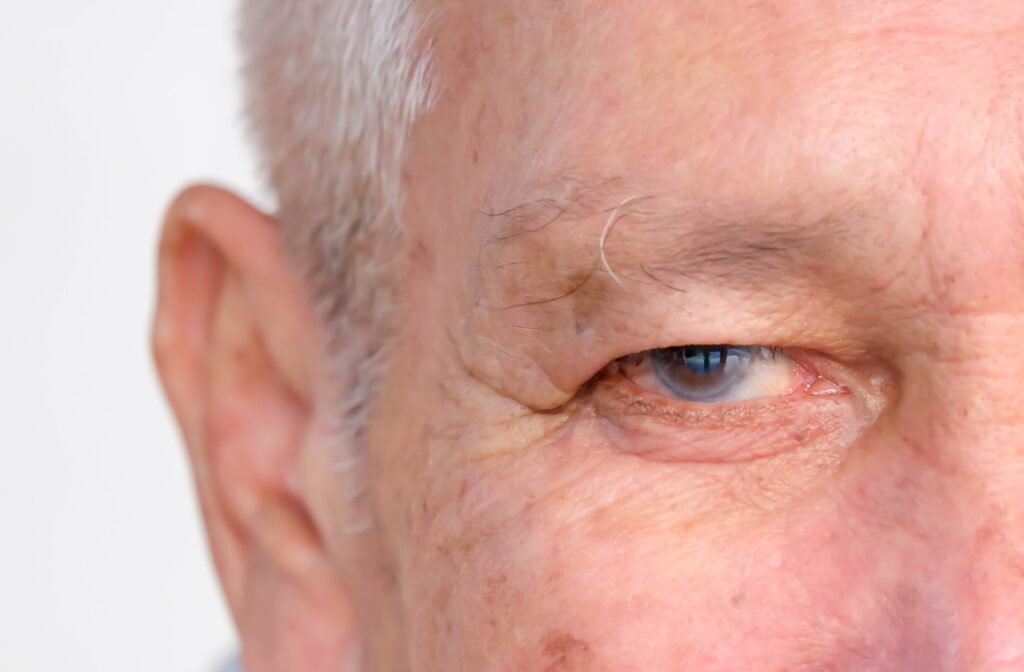Cataracts and dry eyes are two of the most common eye conditions an individual may develop. Yet a common question is: are they related?
In short, no, Dry eyes don’t cause cataracts. Dry eyes and cataracts are two distinct eye conditions that can impact each other and share overlapping symptoms.
Visiting your optometrist for comprehensive eye exams helps determine an accurate diagnosis for eye conditions and provides the most suitable treatment option for your ocular needs.
At InVision Eyecare, we have a specialized Dry Eye Clinic that offers comprehensive diagnoses and treatments for dry eye, including Intense Regulated Pulsed Light (IRPL) therapy and Meibomian gland expression, to provide effective relief from dry eye symptoms.
Understanding Cataracts
Cataracts are a common eye condition characterized by the clouding of the eye’s natural lens. This clouding impairs vision by obstructing the passage of light to the retina. Without treatment, cataracts can lead to significant vision loss.
Cataracts typically develop over time as proteins in the lens begin to break down and clump together, forming cloudy areas. Aging is a primary risk factor for developing cataracts as it’s an (almost) inevitable part of the aging process. Additional risk factors include:
- Ocular history
- Exposure to UV Rays
- Smoking
- Diabetes
- Certain medications
Cataracts develop gradually, beginning with minor vision disturbances that often go unnoticed. Recognizing the symptoms of cataracts early can aid in early diagnosing and determining how far the cataracts have progressed. Some common symptoms include:
- Blurred or cloudy vision: Vision becomes hazy, making it difficult to see clearly.
- Increased sensitivity to light: Bright lights may cause discomfort or glare.
- Difficulty seeing at night: Night vision deteriorates, making activities like driving at night challenging.
- Halos around lights: Lights may appear to have halos or rings around them, especially at night.
- Faded colours: Colours may seem less vibrant or more yellowed.
- Frequent changes in prescription glasses or contact lenses: Rapid vision changes may require frequent updates to prescription eyewear.
- Double vision in a single eye: Experiencing double vision or multiple images in one eye.
While cataracts are a serious ocular condition, they can be treated with surgical intervention. The process involves removing the clouded lens and replacing it with an artificial intraocular lens, restoring clarity and improving quality of life.
Unfortunately, glasses or contact lenses will not improve visual clarity for individuals with cataracts, which can only be treated with surgical intervention.
Additionally, for those suffering from both cataracts and dry eye, treatments such as Intense Regulated Pulsed Light (IRPL) therapy and Meibomian gland expression can be beneficial in managing dry eye symptoms, especially after cataract surgery where dry eye symptoms may be exacerbated.
Connection Between Cataracts & Dry Eyes
To address whether dry eyes can lead to cataracts, it’s important to first understand each condition independently.
Understanding Dry Eyes
Dry eye syndrome is a common condition caused by an unstable tear film, where your eyes don’t produce enough tears or the right quality of tears to lubricate them properly.
The most common cause of dry eye is meibomian gland dysfunction (MGD), a condition in which the meibomian glands in the eyelids don’t produce enough oil. This leads to tears evaporating too quickly, which often results in discomfort or irritation. Treatments such as Intense Regulated Pulsed Light (IRPL) therapy and Meibomian gland expression can help address these issues by improving gland function and oil secretion.
Dry eyes can temporarily blur vision and make the eyes feel tired. The discomfort can significantly affect daily activities. Prolonged screen time, dry air, and certain medications often exacerbate the symptoms of dry eyes.
Overlapping Symptoms of Cataracts & Dry Eyes
Interestingly, some symptoms of dry eyes and cataracts do overlap. These overlapping symptoms can lead an individual to misdiagnose or confuse the 2 conditions. This is why it’s important to consult your optometrist for an accurate diagnosis.
These overlapping symptoms include:
- Blurred vision: Both dry eyes and cataracts can cause blurred vision. In dry eyes, this occurs because the tear film isn’t adequately lubricating the eye’s surface, while in cataracts, it’s due to the clouding of the eye’s lens.
- Increased sensitivity to light: Patients with dry eyes often experience photophobia or sensitivity to light because of the inadequate tear film protecting the eye. Similarly, cataract sufferers also report increased glare and light sensitivity due to the scattering of light in the clouded lens.
- Difficulty seeing at night: Night vision can be impaired in both conditions. For dry eye patients, the lack of a stable tear film can cause visual disturbances in low light, while cataracts can make it harder to see at night due to the lens’s cloudiness.
Treatment for cataracts and dry eyes differ. Cataracts can only be surgically treated, while there are several therapies available for alleviating dry eye symptoms, including:
- Eye drops: Artificial tears or prescription eye drops can help temporarily relieve dry eye symptoms.
- Warm compress: The moisture from the compress helps hydrate the eye to relieve symptoms.
- Intense regulated pulsed light (IRPL) therapy: IRPL helps reduce inflammation and improve the function of the meibomian glands to reduce the evaporation of tears.
- Meibomian gland expression: In-office expressions involve applying pressure to the eyelids to clear any obstructed oils.
Visiting your optometrist is key for determining the most suitable form of dry eye therapy for your ocular needs.

Can Cataracts Aggravate Symptoms of Dry Eyes?
While cataracts and dry eyes are distinct conditions, they can influence one another and exacerbate symptoms.
Cataracts primarily cause cloudiness in the lens, but the surgery to remove them can sometimes aggravate dry eye symptoms. During cataract surgery, an incision is made in the cornea, which can temporarily disrupt the tear film, resulting in dry eye symptoms post-surgery.
Conversely, severe dry eyes can complicate the diagnosis and treatment of cataracts. For instance, dry eye symptoms, like blurred vision and increased glare, might mask or mimic the symptoms of cataracts, leading to potential delays in seeking appropriate treatment.
How Cataracts Are Detected
Aging is a primary risk factor for developing cataracts, making routine exams all the more important in detecting and diagnosing eye conditions like cataracts and dry eyes.
Annual eye exams become important for individuals who are 65 and over due to the increased risk of vision problems associated with aging. These can include:
- Trouble distinguishing colours
- Difficulty seeing at night and low vision
- Glare sensitivity
- Cataracts
- Age-related macular degeneration (AMD)
- Eye injuries related to falls
Cataracts are most commonly detected through a comprehensive eye exam. During this exam, your optometrist will monitor any changes in your visual acuity, and monitor the health of the eye through retinal photos, OCT imaging, and a slit lamp examination to confirm the presence and severity of a cataract.
Depending on the progression and severity of the cataract, your optometrist will explain the most suitable time to undergo cataract surgery and what to expect during the procedure.
Schedule an Appointment!
While dry eyes don’t cause cataracts, understanding the link between the two eye conditions helps maintain ocular health. Regular eye exams, early detection, and appropriate treatment are key to managing these conditions.Our team at InVision Eye Care Centre can help. Connect with us to schedule your routine eye exam!



